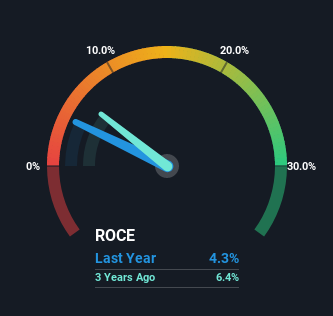Murudeshwar Ceramics (NSE:MURUDCERA) Is Finding It Tricky To Allocate Its Capital

If we're looking to avoid a business that is in decline, what are the trends that can warn us ahead of time? A business that's potentially in decline often shows two trends, a return on capital employed (ROCE) that's declining, and a base of capital employed that's also declining. Basically the company is earning less on its investments and it is also reducing its total assets. So after glancing at the trends within Murudeshwar Ceramics (NSE:MURUDCERA), we weren't too hopeful.
What is Return On Capital Employed (ROCE)?
If you haven't worked with ROCE before, it measures the 'return' (pre-tax profit) a company generates from capital employed in its business. Analysts use this formula to calculate it for Murudeshwar Ceramics:
Return on Capital Employed = Earnings Before Interest and Tax (EBIT) ÷ (Total Assets - Current Liabilities)
0.043 = ₹156m ÷ (₹4.7b - ₹1.1b) (Based on the trailing twelve months to December 2021).
Therefore, Murudeshwar Ceramics has an ROCE of 4.3%. In absolute terms, that's a low return and it also under-performs the Building industry average of 17%.
Check out our latest analysis for Murudeshwar Ceramics

While the past is not representative of the future, it can be helpful to know how a company has performed historically, which is why we have this chart above. If you'd like to look at how Murudeshwar Ceramics has performed in the past in other metrics, you can view this free graph of past earnings, revenue and cash flow.
What Can We Tell From Murudeshwar Ceramics' ROCE Trend?
In terms of Murudeshwar Ceramics' historical ROCE movements, the trend doesn't inspire confidence. To be more specific, the ROCE was 5.5% five years ago, but since then it has dropped noticeably. On top of that, it's worth noting that the amount of capital employed within the business has remained relatively steady. This combination can be indicative of a mature business that still has areas to deploy capital, but the returns received aren't as high due potentially to new competition or smaller margins. So because these trends aren't typically conducive to creating a multi-bagger, we wouldn't hold our breath on Murudeshwar Ceramics becoming one if things continue as they have.
In Conclusion...
In summary, it's unfortunate that Murudeshwar Ceramics is generating lower returns from the same amount of capital. Long term shareholders who've owned the stock over the last five years have experienced a 45% depreciation in their investment, so it appears the market might not like these trends either. With underlying trends that aren't great in these areas, we'd consider looking elsewhere.
If you want to know some of the risks facing Murudeshwar Ceramics we've found 3 warning signs (1 can't be ignored!) that you should be aware of before investing here.
While Murudeshwar Ceramics may not currently earn the highest returns, we've compiled a list of companies that currently earn more than 25% return on equity. Check out this free list here.
If you're looking to trade Murudeshwar Ceramics, open an account with the lowest-cost platform trusted by professionals, Interactive Brokers.
With clients in over 200 countries and territories, and access to 160 markets, IBKR lets you trade stocks, options, futures, forex, bonds and funds from a single integrated account.
Enjoy no hidden fees, no account minimums, and FX conversion rates as low as 0.03%, far better than what most brokers offer.
Sponsored ContentNew: Manage All Your Stock Portfolios in One Place
We've created the ultimate portfolio companion for stock investors, and it's free.
• Connect an unlimited number of Portfolios and see your total in one currency
• Be alerted to new Warning Signs or Risks via email or mobile
• Track the Fair Value of your stocks
Have feedback on this article? Concerned about the content? Get in touch with us directly. Alternatively, email editorial-team (at) simplywallst.com.
This article by Simply Wall St is general in nature. We provide commentary based on historical data and analyst forecasts only using an unbiased methodology and our articles are not intended to be financial advice. It does not constitute a recommendation to buy or sell any stock, and does not take account of your objectives, or your financial situation. We aim to bring you long-term focused analysis driven by fundamental data. Note that our analysis may not factor in the latest price-sensitive company announcements or qualitative material. Simply Wall St has no position in any stocks mentioned.
About NSEI:MURUDCERA
Murudeshwar Ceramics
Manufactures and trades in ceramic and vitrified floor and wall tiles in India, the Americas, Europe, and internationally.
Proven track record with adequate balance sheet and pays a dividend.
Similar Companies
Market Insights
Community Narratives



